ELEDIA Research Center
ELEDIA@UniTN ‐ University of Trento
Via Sommarive 9, I‐38123 Trento, Italy
E‐mail: andrea.massa@unitn.it
Web: www.eledia.org/eledia‐unitn
Laboratoire des Signaux et Systèmes
UMR8506 (CNRS‐CENTRALE SUPELEC‐UNIV. PARIS SUD)
rue Joliot‐Curie 3, 91192 Gif‐sur‐Yvette, France
E‐mail: andrea.massa@l2s.centralesupelec.fr
Web: www.eledia.org/eledia‐l2s
Optimization Theory, Techniques,
and MATLAB simulations
Global (Evolutionary) Optimization Methods
Prof. Andrea MASSA
UESTC “2018 International Summer School”
July 16‐20, 2018 – Chengdu, China
Outline
(1) What are EAs?
What are EAs?
(2) How are EAs defined?
How are EAs defined?
(3) Why and where using EAs?
Why and where using EAs?
(4) Conclusions
Conclusions
Copyright Notice
All rights to the content of this document are reserved. Any use, in whole or
in part, of the contents included in this document, including the storage,
reproduction, editing, dissemination or distribution of their content through any
technology platform, support, or computer network is forbidden without the
prior written permission from the author.
Tutti i diritti relativi ai contenuti del presente documento sono riservati. È
vietato qualsiasi utilizzo, totale o parziale, dei contenuti inseriti nel presente
documento, ivi inclusa la memorizzazione, riproduzione, rielaborazione,
diffusione o distribuzione dei contenuti stessi mediante qualunque piattaforma
tecnologica, supporto o rete telematica, senza previa autorizzazione scritta da
parte dell’autore.
ELEDIA Research Center – All Rights Reserved
What are EAs?
What are EAs?
EAs are Methods for determining the Solution of Problems ...
… but the Problems MUST be properly reformulated as
suitable Optimization Problems
Problem
Problem
Eating
• Good meal
• In a lovely place
Where to go?
Solution
Solution
Restaurant in Paris
Home
Restaurant in Chengdu
McDonald’s
ELEDIA Research Center – All Rights Reserved
3
ELEDIA Research Center – All Rights Reserved
2
4
�
Original Problem
Original Problem
Optimization Problem
Optimization Problem
Problem Statement
Problem Reformulation
Problem usually defined by means of an Objective and
a Set of Constraints or Requirements to be satisfied
Problem Objective
Problem Objective
Eating!
Constraints/Requirements
Constraints/Requirements
• Good meal
• In a lovely place
ELEDIA Research Center – All Rights Reserved
Optimization Problem –– An Example
An Example
Optimization Problem
Cost Function:
Food‐Quantity
( )
f
Φ
+=
1
1
4000
N
∑
n
=
1
(
f
n
−
100
)
2
N
∏−
=
n
1
cos
(
−
f
n
100
n
)
Griewank function
Constraints:
• Good meal
• In a lovely place
0
≤ f
≤−
5
1 ≤
f
5
−≤
2
5
ELEDIA Research Center – All Rights Reserved
2=N
2=N
5
7
An Optimization Problem models the Objective as a Cost
Function to be min‐maximize subject to a Set of Constraints
or Requirements
Problem Objective
Problem Objective
Eating!
Constraints/Requirements
Constraints/Requirements
Cost Function
Food‐Quantity
Constraints
• Good meal
• In a lovely place
Meal‐Quality > Delicious
Place > Historical City
ELEDIA Research Center – All Rights Reserved
Problem Solution –– An Example
An Example
Problem Solution
Cost Function
( )
f
+=
Φ
1
1
4000
Constraints
(
f
n
−
100
)
2
N
∏−
=
n
1
cos
(
−
f
n
100
n
)
• Good meal
• In a lovely place
N
∑
n
=
1
0
≤ f
≤−
5
1 ≤
f
5
−≤
2
Problem Solution
Maximization Problem Solution
Maximization
]
( )
}f
f opt
=
arg
{
max
[
Φ
max
≡
f
Solution Parameters
f
1
f
2
=
=
5.2
0.0
Problem Solution
Minimization Problem Solution
Minimization
]
( )
}f
f opt
=
arg
{
min
[
Φ
min
=
f
ELEDIA Research Center – All Rights Reserved
5
6
8
�
Optimization Problem
Optimization
Problem -- Properties
Properties
Optimization Problem
Optimization Problem
Property No. 1
Property No. 2
( ) 0≥
Φ f
max
{
Φ
( )
}
f
≡
{
1min
( )
}f
Φ
Problem Solution
Univocally Determine the set of unknown Parameters (the
coordinates of the location) satisfying the problem constraints
by min‐maximizing the cost function
max
=
arg
min
=
arg
f
f
=
{
max
[
{
Φ
min
]
[
( )
}
Φ
f
]
( )
}
f
[
{
1min
arg
[
{
1max
=
arg
]
( )
}f
Φ
]
( )
}f
Φ
Restaurant
in Paris
Home
McDonald’s
Restaurant
in Chengdu
ELEDIA Research Center – All Rights Reserved
9
ELEDIA Research Center – All Rights Reserved
10
The Nature of Optimization Problems
The Nature of Optimization Problems
- Multiminima Functionals -
Problem Statement: Eating good meal in a lovely place!
Cost Function
Cost Function
McDonald’s
Restaurant in Paris
Restaurant in Chengdu
Solution
Solution
The Nature of Optimization Problems
The Nature of Optimization Problems
- Multiminima Functionals -
Local minima attraction basins
Local Minima
Local minima points are
attractors of the search trajectory
generated by deterministic
local search
Global Minimum
Global minimum
attraction basin
The smallest value
that a function takes
on the function domain
ELEDIA Research Center – All Rights Reserved
11
ELEDIA Research Center – All Rights Reserved
12
�
The Nature of Optimization Problems
The Nature of Optimization Problems
Local Minima: Benefit or Problem?
Local Minima: Benefit or Problem?
Two local minima are neighbors if and only if
their attraction basins are neighbors
Local minimum
“The ensemble
of the attraction basins
forms the function landscape”
“The values of the objective function at local minima
are (generally) better than the values at the starting points”
In a minimization problem, the probability
of low values of the objective function
is larger for local minima than for a point
randomly extracted from the function landscape
“In one search for low‐cost solutions,
sampling local minima is more effective
than sampling random points”
[*] R. Battiti, et al., Reactive Search and Intelligent Optimization.Operations Research/Computer Science Interfaces Series, Vol. 45, Springer, November 2008.
[*] R. Battiti, et al., Reactive Search and Intelligent Optimization.Operations Research/Computer Science Interfaces Series, Vol. 45, Springer, November 2008.
ELEDIA Research Center – All Rights Reserved
13
ELEDIA Research Center – All Rights Reserved
14
Local Minima: TabuTabu
Local Minima:
“The memory about the previously found
local minima, can be mined to produce better
and better starting points”
LEARNING from
the previous history
Iterated Search
)fΦ
(
Penalty Term
Once the local minimum “a”
is found, the penalty term
allows to avoid the search
in the attraction basin of “a”
in the next iterations.
[*] R. Battiti, et al., Reactive Search and Intelligent Optimization.Operations Research/Computer Science Interfaces Series, Vol. 45, Springer, November 2008.
f
Optimization Meaning/Needs
Optimization Meaning/Needs
“Optimization as Information Exploitation”
The Importance of Knowing
Analytical framework
A‐priori information
Eating!
“I can eat at home!”
“Definition of the Boundary Landscape”
Problem Bounds
ELEDIA Research Center – All Rights Reserved
15
ELEDIA Research Center – All Rights Reserved
16
�
Optimization as Information Exploitation
Optimization as Information Exploitation
Optimization as Information Exploitation
Optimization as Information Exploitation
The Importance of Knowing
The Importance of Knowing
Open the door
MainMain Entrance
Entrance
Iteration 1
Not there!
Iteration 2
Tv Room
Tv Room
I cannot eat here
Information Acquisition
Information Acquisition ‐ Tabu
ELEDIA Research Center – All Rights Reserved
17
ELEDIA Research Center – All Rights Reserved
18
Optimization as Information Exploitation
Optimization as Information Exploitation
Optimization as Information Exploitation
Optimization as Information Exploitation
The Importance of Knowing
The Importance of Learning
Kitchen
Kitchen
There is food !
“The fly isn’t intelligent.
Attracted by the light bulb,
it is repeatedly burnt”
Iteration 3
Memory Setup
Information Acquisition
ELEDIA Research Center – All Rights Reserved
19
ELEDIA Research Center – All Rights Reserved
20
�
The Importance of Information
The Importance of Information
“Human problem solving is strongly connected to learning.
Learning takes places when the problem at hand
is not well known at the beginning,
and its structure becomes more and more clear
when more experience with the problem is available”
Information Exploitation
Define the Bounds
of the Problem Landscape
Memory Setup
Knowing Problem Landscape
[*] R. Battiti et al., Reactive Search and Intelligent Optimization.Operations Research/Computer Science Interfaces Series, Vol. 45, Springer, November 2008.
EAs as …… Information Exploitation
Information Exploitation
EAs as
Tools
Tools
Optimization
Methods
Local
Techniques
Conjugate Gradient
Methods
Quasi‐Newton
Methods
Convex Programming
Linear Programming
Greedy Algorithm
Global
Techniques
Random Walk
Simulated Annealing (SA)
Tabu Search
Genetic Algorithms (GAs)
Memetic Algorithm (MA)
Differential Evolution (DE)
Particle Swarm (PSO)
Ant Colony (ACO)
Bacteria Foraging (BF)
}
Single
Agent
Multiple
Agent
(EAs)
ELEDIA Research Center – All Rights Reserved
21
ELEDIA Research Center – All Rights Reserved
22
Local vs. Global Approaches
Local vs. Global Approaches
Which initial locations are suitable to reach the global minimum?
Local Techniques
Local Techniques
Initialization (k=0):
Guess (approximate) solution
)
af
(
0
Iterative Procedure:
f
a
(
=+
k
)
1
f
)
a
(
k
+
s
k
k
,...,1=
K
Global Search Algorithms
Algorithms able to escape
from local minima points
Local Search Algorithms
Algorithms which only
exploring the neighborhood
of a local minimum point
Local strategies can reach the global optimum if and only if
Local strategies can reach the global optimum
if and only if their
their
search starts in the attraction basin of the global optimum
search starts in the attraction basin of the global optimum
s α=
k
k
d
k
kα Step Length
kd
Search Direction
(
)0>kα
Approaches:
Steepest Descent Method
Conjugate Gradient Method
ELEDIA Research Center – All Rights Reserved
23
ELEDIA Research Center – All Rights Reserved
24
�
Local Technique – Search Direction
Local Techniques – Step Length
f
a
(
=+
k
)
1
f
)
a
(
k
α+
k
d
k
d
(
f
k H
Φ∇=
[
]k
)
“Direction expressed as
a function of the gradient
of the cost function”
( )fΦ
)
(a
kf
kd
)
(a
kf
kd
f
a
(
=+
k
)
1
f
)
a
(
k
α+
k
d
k
Cut of
along
( )fΦ
kd
)
(a
kf
kdα
k
α
k
:
Φ
(
f
)
a
(
)
k
1
+
(
f
Φ=
)
a
(
k
+
α
k
d
k
)
=
{
min
Φ
α
>
0
( )fΦ
“Objective is to achieve
the local minimum”
(
f
)
a
(
k
+
d
α
)
}k
ELEDIA Research Center – All Rights Reserved
25
ELEDIA Research Center – All Rights Reserved
26
Global Techniques
Global Techniques
Approaches:
Single‐Agent Technique
f
- Simulated Annealing
- Tabù Search
Multiple‐Agent Technique
- Evolutionary Algorithms
a
(
k
)
1
=+
f
)
a
(
k
+
s
k
Solution increment
defined through a
stochastic method
)
f
p
pa
)(
(
k
1
+
=
f
=
,...,1
)
pa
)(
(
k
p
)
+
s
(
k
P
Advantages and Drawbacks
Advantages and Drawbacks
Optimization
Methods
Local
Techniques
Global
Techniques
Deterministic Algorithms
Stochastic Algorithms
Effective in term of
computational cost
Local minima problem
…
Single Agent
Multiple Agent
ELEDIA Research Center – All Rights Reserved
27
ELEDIA Research Center – All Rights Reserved
28
�
Advantages of EAs
Advantages of EAs
Global search
Hill‐climbing features (no local “minima” problem)
No differentiation
Straightforward introduction of a‐priori information
(or constraints)
Discrete / continuous space
Intrinsically parallel computing
Hybridization with deterministic procedures
Drawbacks:
Computational load
Low convergence rate
Do they exist?
How to mitigate?
EAs as Optimal/General
Purpose Tools?
The “Holy Grail” for
Problem Optimization?
ELEDIA Research Center – All Rights Reserved
29
ELEDIA Research Center – All Rights Reserved
30
Optimization Paradigms
Optimization Paradigms
“Which Algorithm is More Suitable for the Solution of
an Optimization Problems?”
DE
GAs
PSO
“The Lunch
is
No‐Free” [*]
ACO
MA
BF
…
Optimization Theorems
Optimization Theorems
Theorem 1
[*]
Algorithms
Problems
“The average performance
of any pair of algorithms
across all possible problems
is identical”
Implication:
Representative Example
“If an algorithm performs better than random search on
some class of problems then in must perform worse than
random search on the remaining problems”
[*] D.H. Wolpert et al., IEEE Trans. Evol. Comput., vol. 1, no. 1, pp. 67‐82, Apr.1997.
[*] D.H. Wolpert et al., IEEE Trans. Evol. Comput., vol. 1, no. 1, pp. 67‐82, Apr.1997.
ELEDIA Research Center – All Rights Reserved
31
ELEDIA Research Center – All Rights Reserved
32
�
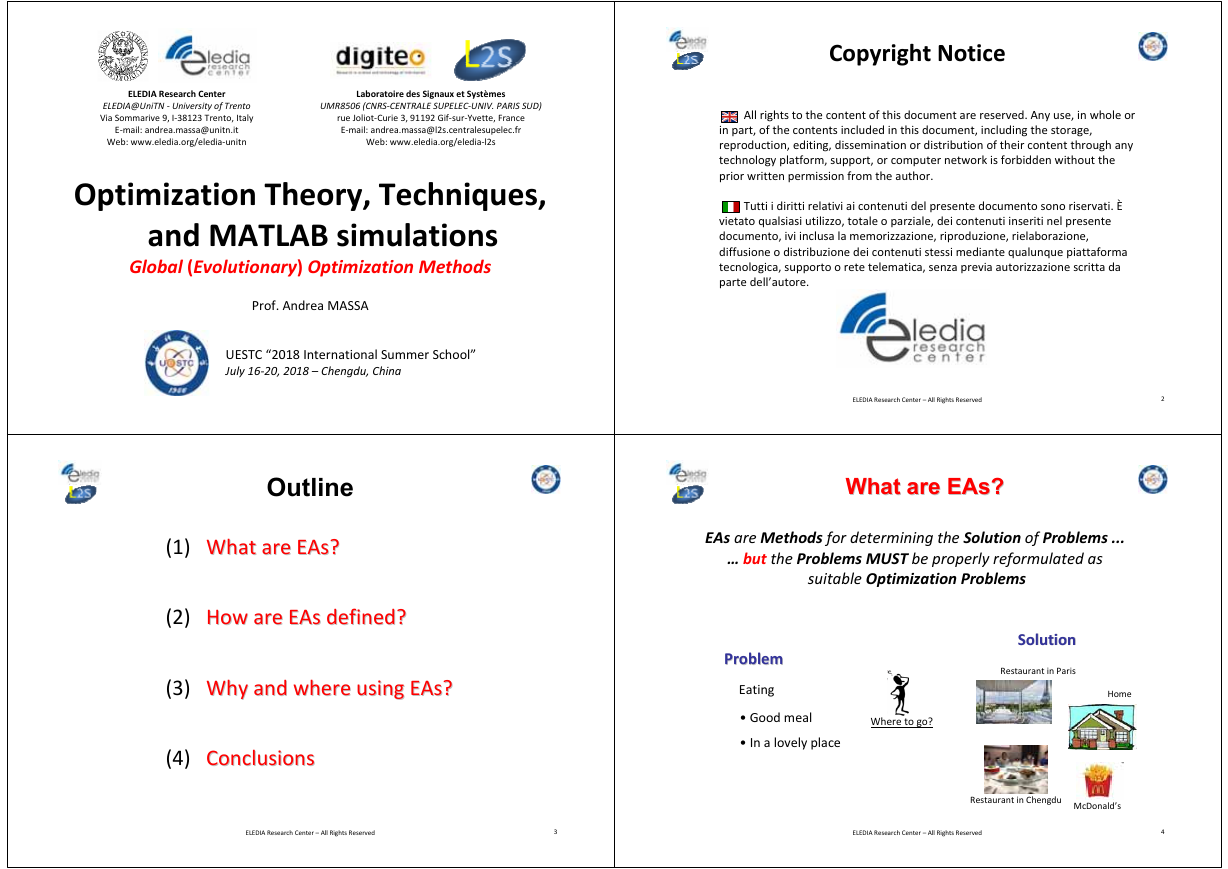
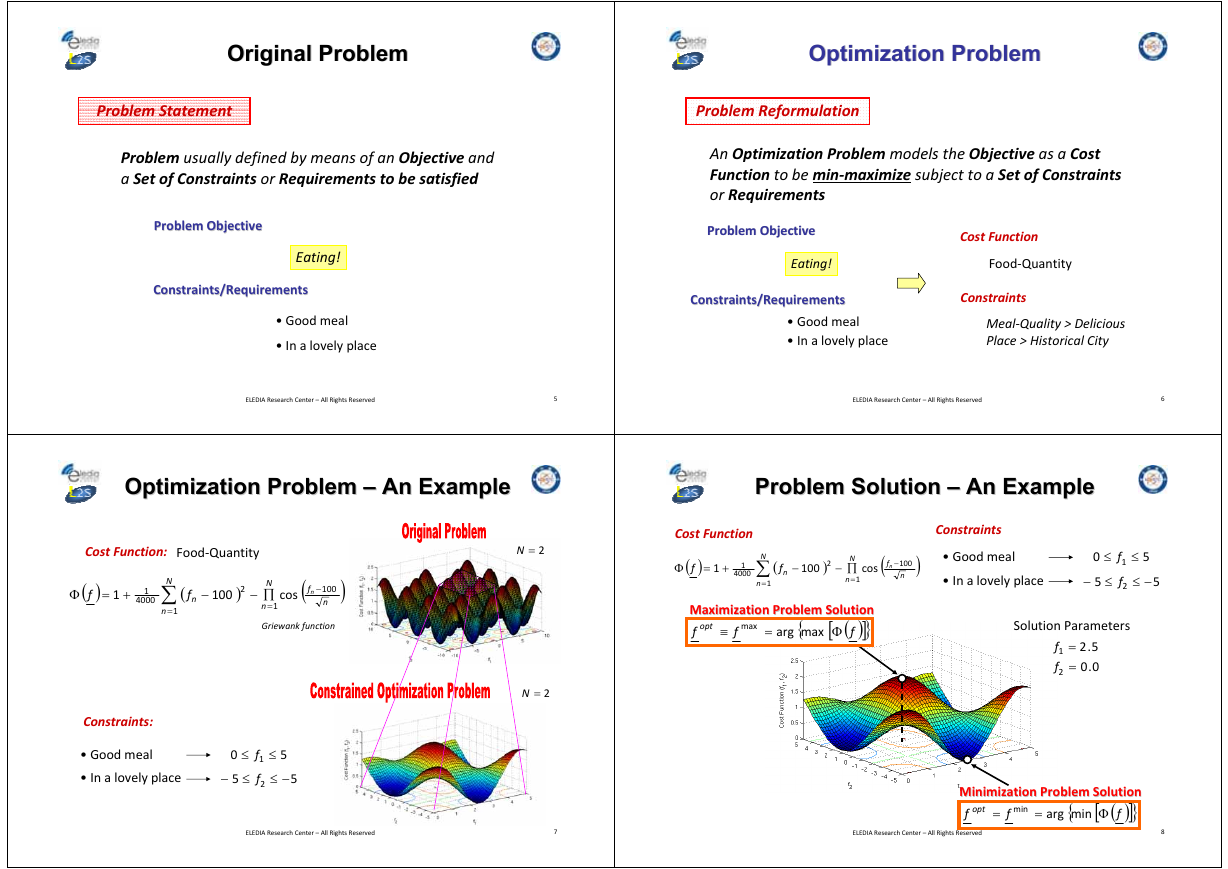
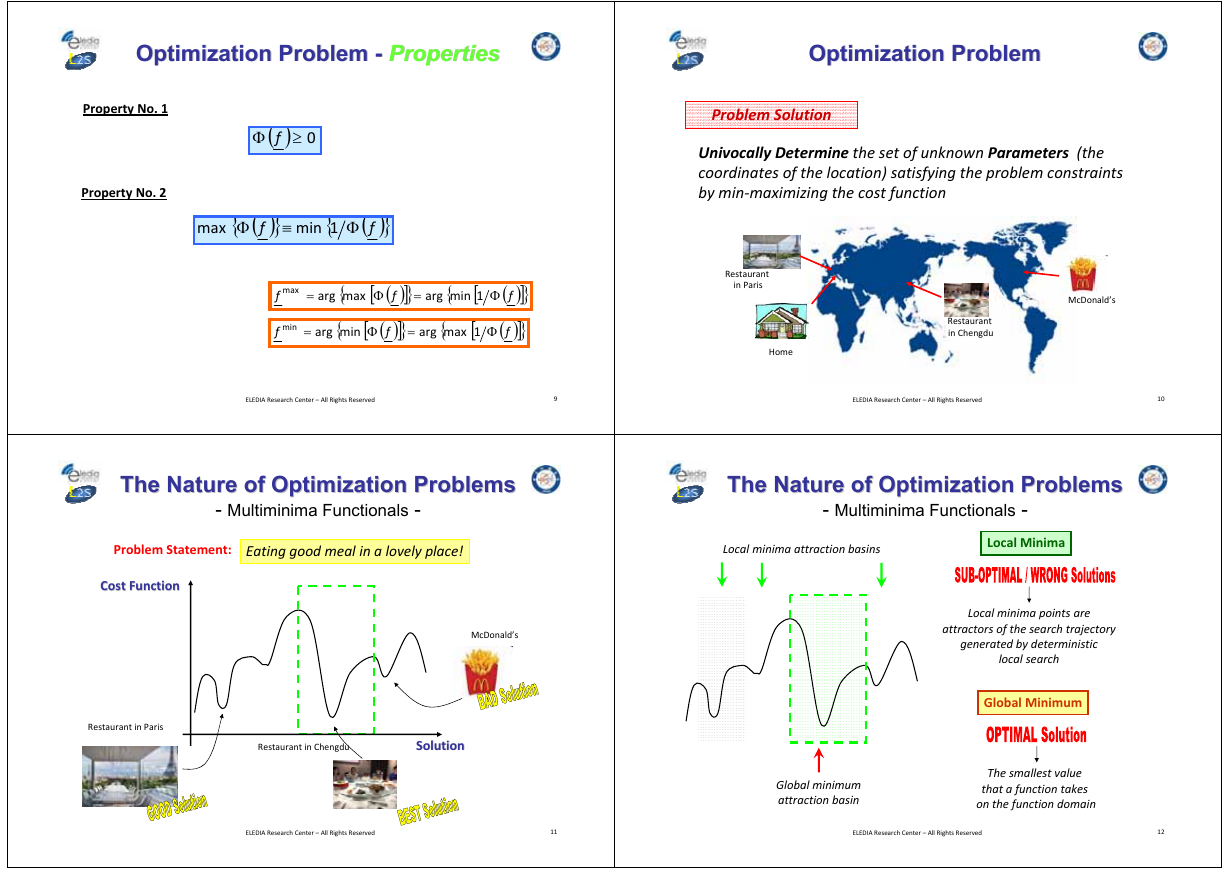

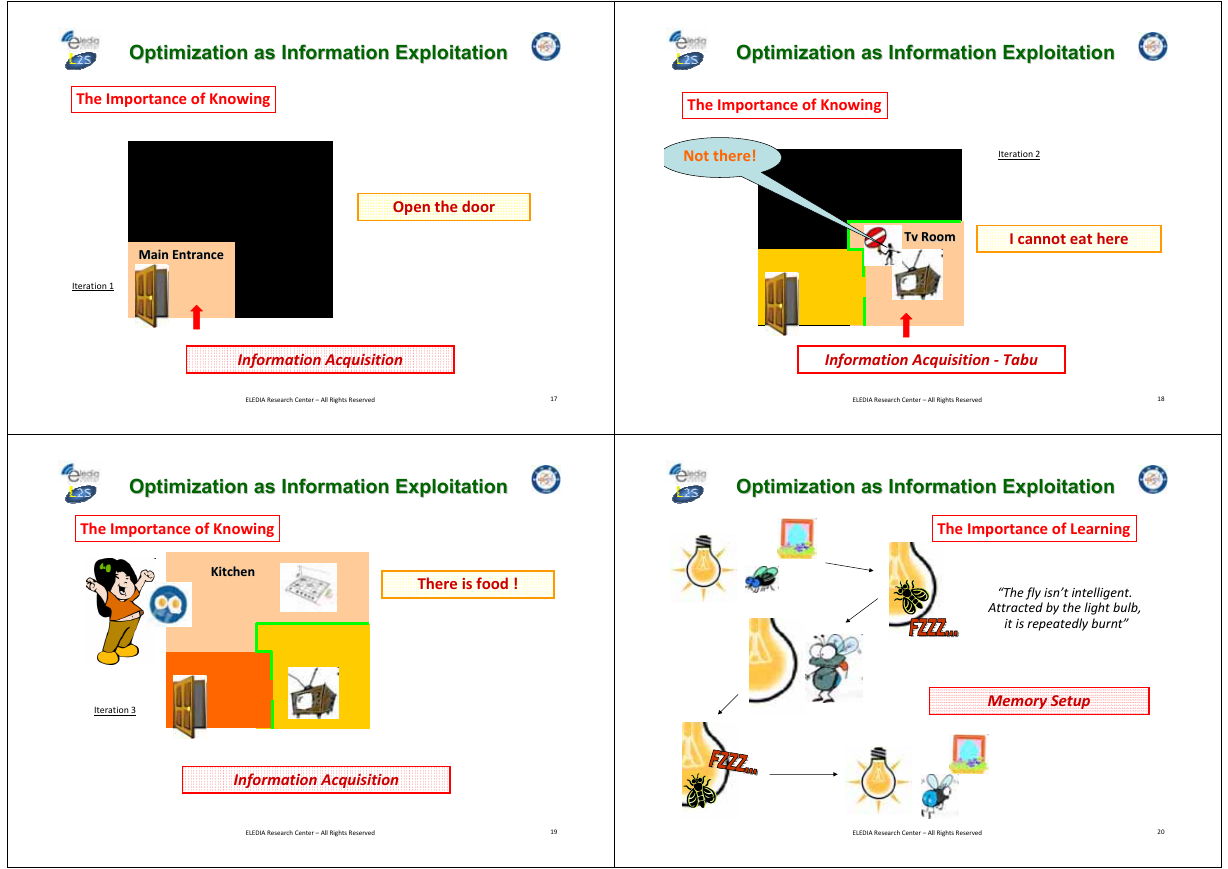
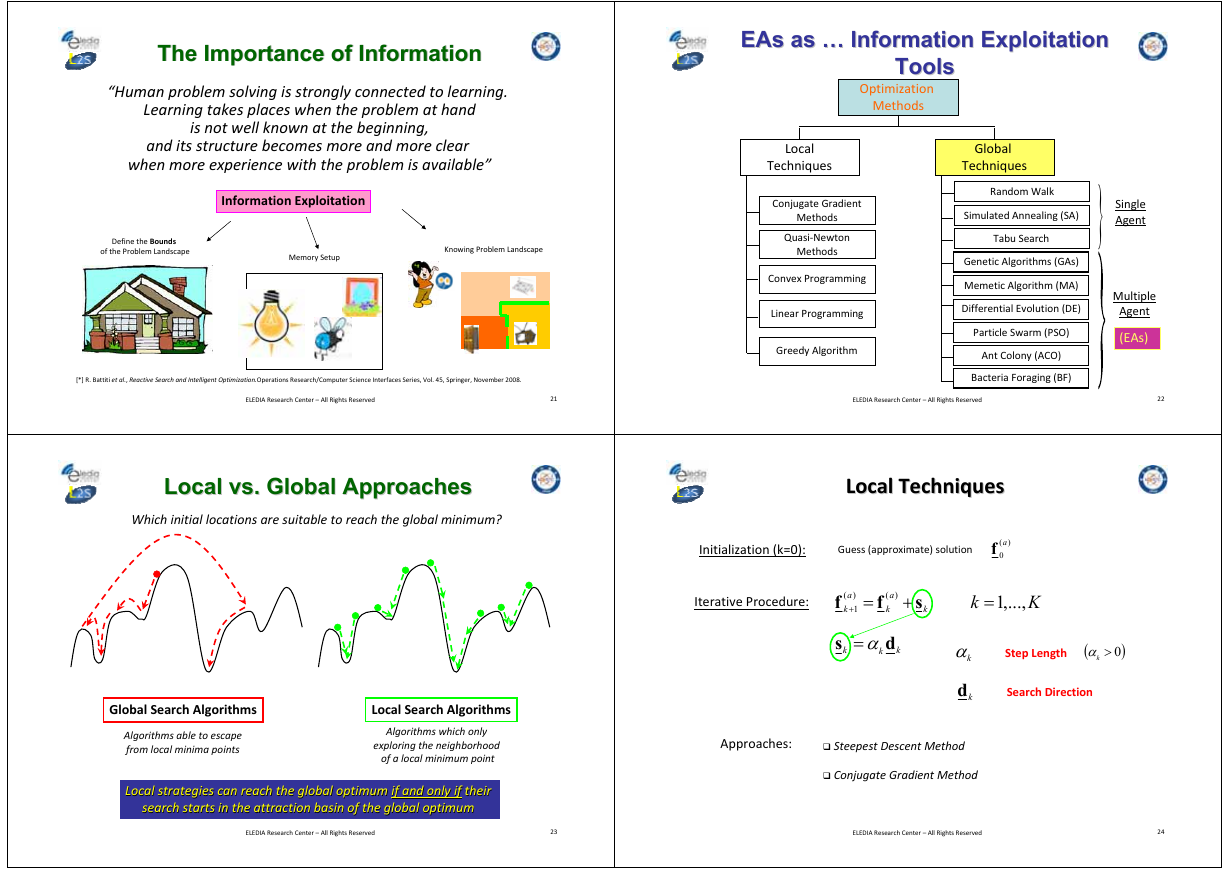
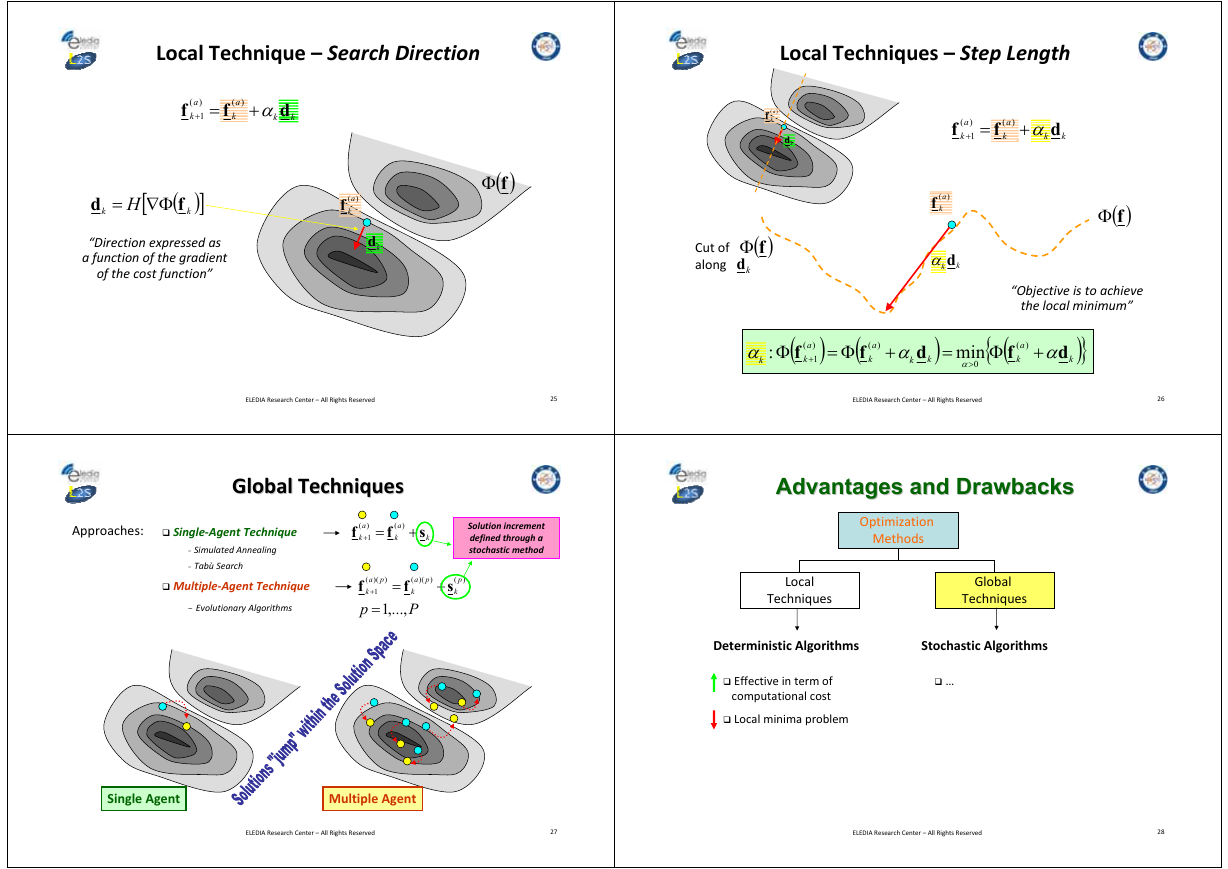
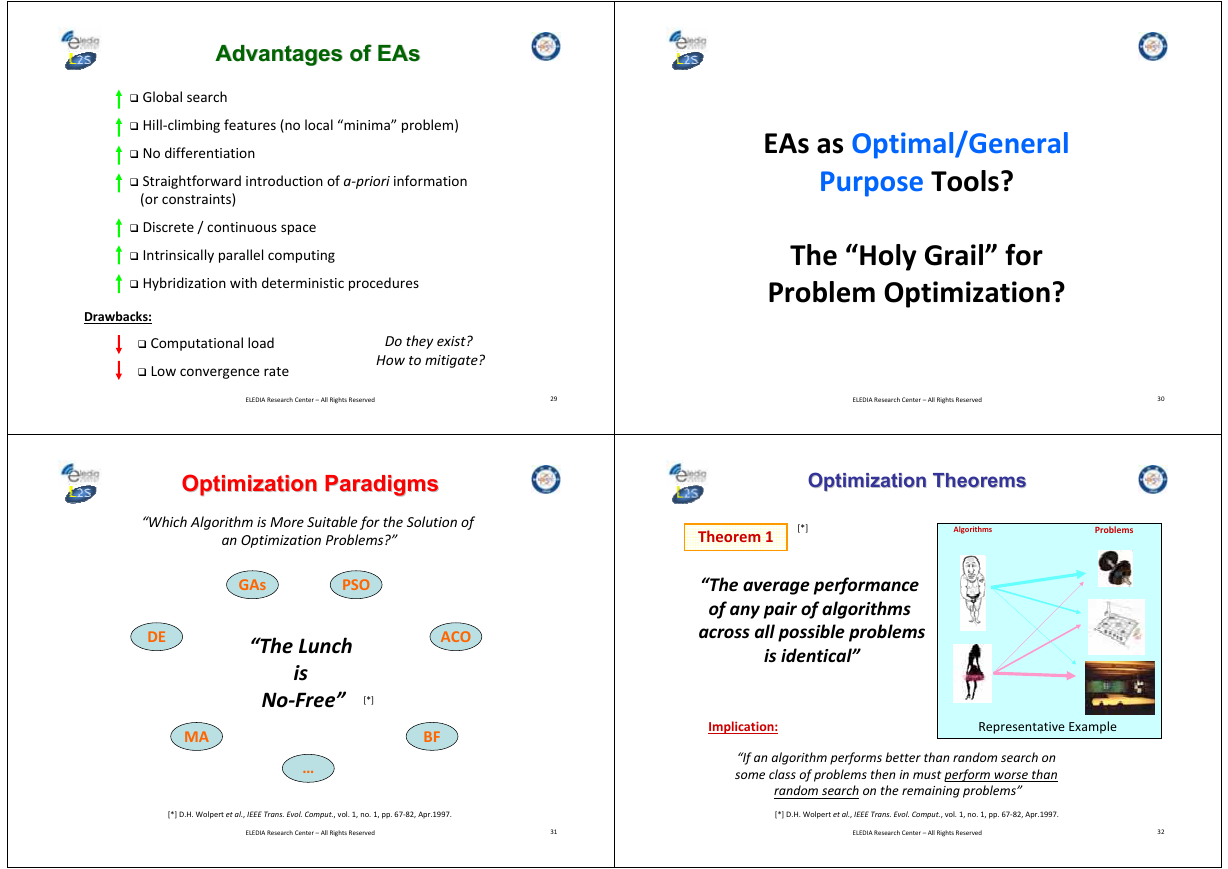








 2023年江西萍乡中考道德与法治真题及答案.doc
2023年江西萍乡中考道德与法治真题及答案.doc 2012年重庆南川中考生物真题及答案.doc
2012年重庆南川中考生物真题及答案.doc 2013年江西师范大学地理学综合及文艺理论基础考研真题.doc
2013年江西师范大学地理学综合及文艺理论基础考研真题.doc 2020年四川甘孜小升初语文真题及答案I卷.doc
2020年四川甘孜小升初语文真题及答案I卷.doc 2020年注册岩土工程师专业基础考试真题及答案.doc
2020年注册岩土工程师专业基础考试真题及答案.doc 2023-2024学年福建省厦门市九年级上学期数学月考试题及答案.doc
2023-2024学年福建省厦门市九年级上学期数学月考试题及答案.doc 2021-2022学年辽宁省沈阳市大东区九年级上学期语文期末试题及答案.doc
2021-2022学年辽宁省沈阳市大东区九年级上学期语文期末试题及答案.doc 2022-2023学年北京东城区初三第一学期物理期末试卷及答案.doc
2022-2023学年北京东城区初三第一学期物理期末试卷及答案.doc 2018上半年江西教师资格初中地理学科知识与教学能力真题及答案.doc
2018上半年江西教师资格初中地理学科知识与教学能力真题及答案.doc 2012年河北国家公务员申论考试真题及答案-省级.doc
2012年河北国家公务员申论考试真题及答案-省级.doc 2020-2021学年江苏省扬州市江都区邵樊片九年级上学期数学第一次质量检测试题及答案.doc
2020-2021学年江苏省扬州市江都区邵樊片九年级上学期数学第一次质量检测试题及答案.doc 2022下半年黑龙江教师资格证中学综合素质真题及答案.doc
2022下半年黑龙江教师资格证中学综合素质真题及答案.doc